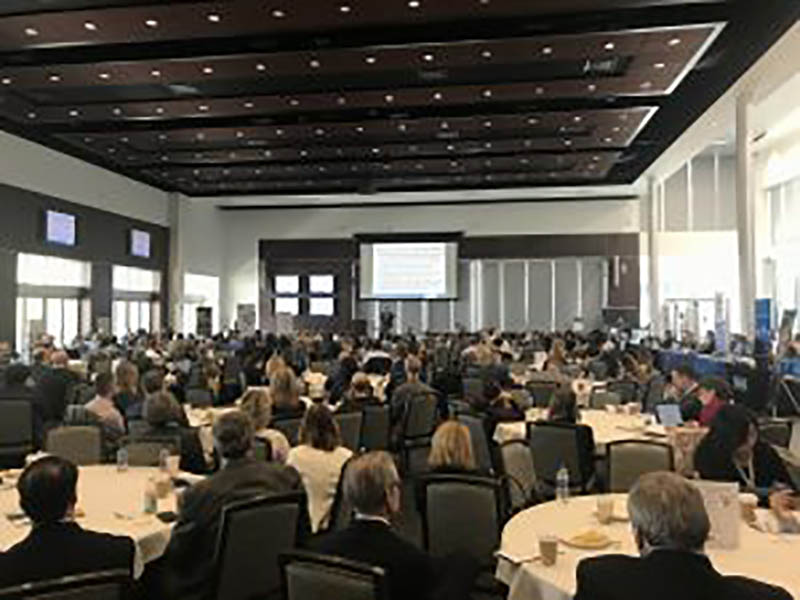We often talk about healthcare technology in terms of benefits such as time savings or cost savings. But what about the human benefits? For providers that means a better quality of life. The same is true of patients – although that better quality of life often means better treatment of disease and a higher life expectancy.
This intersection of technology and humanity took center stage at the New England HIMSS Spring Conference, held on May 16th at Gillette Stadium in Foxboro, Mass. Here are some highlights and takeaways from the event.
Patients + providers = collaborators
The most moving presentation at the New England HIMSS Conference was by Dave deBronkart (“ePatient Dave”) and Dr. Danny Sands. The two men role-played discussions with a patient and a doctor using ePatient Dave’s real-life kidney cancer diagnosis as the backdrop.
The men presented two types of discussions – one “traditional” discussion and one in which digital health and an exchange of information between patient and doctor played central roles. The goal was to show how collaboration between patients and providers results in greater trust, which leads to better care.
ePatient Dave and Dr. Sands even finished their presentation singing their own version of Robert Palmer’s “Bad Case of Loving You” (Doctor, Doctor!) Definitely the first time I’ve seen a song as part of a conference presentation!
Healthcare needs to move from traditional asymmetry model to information symmetry —> doctors and patients are collaborators and partners. @ePatientDave @DrDannySands #NewEnglandHIMSS
— Kathy Sucich (@ksucich) May 16, 2019
Patients and clinicians both believe healthcare is like a carwash. Patients go into the system. Have things done to them and emerge clean/healthy. That model is wrong. Patients should not be passive. Via @DrDannySands #NewEnglandHIMSS #NEHIMSS pic.twitter.com/exJBY4qNEk
— Colin Hung (@Colin_Hung) May 16, 2019
Tackling physician burnout
In addition to taking better care of patients, it’s important for healthcare organizations to take better care of their physicians. Dr. Alain Chaoui, president of the Massachusetts Medical Society, and Dr. Larry Garber, medical director for informatics at Reliant Medical Group, tackled the issue of physician burnout during their presentation.
According to Dr. Chaoui, burnout results from the collision of norms between a physician’s mission to provide patient care and the bureaucratic process. The effects are both personal and professional. About 400 physicians each year commit suicide as a result of burnout. Many others retire early, go into a field other than medicine, or stay in medicine, but in a role other than direct patient care.
50% of physicians experience at least one symptom of #burnout – 2x the risk of the general population. #NewEnglandHIMSS
— Kathy Sucich (@ksucich) May 16, 2019
Dr. Garber talked about how Reliant has tried to make improvements with its EHR to “make it easy for the right person to do the right thing.” That means that physicians will not always be responsible for every click or approval. As a result of Reliant’s efforts, the organization is currently ranked in the top 3% of healthcare organizations nationwide in physician acceptance of the EHR.
Dr. Larry Garber of @GetReliant offers the healthcare organization’s three principles for its #EHR. #NewEnglandHIMSS pic.twitter.com/MS1YGfOHfe
— New England HIMSS (@NewEnglandHIMSS) May 16, 2019
Ensuring information exchange across the care continuum
Highlights from the afternoon sessions at the New England included a session from Micky Tripathi, president & CEO of the Massachusetts eHealth Collaborative. He discussed interoperability efforts – where we are with interoperability and some of the issues we need to think about as we move forward.
We’ve cleared the 1st hill of nationwide #Interoperability with >80% of providers on @CarequalityNet or @CommonWell per @mickytripathi1 at #NEHIMSS #NewEnglandHIMSS pic.twitter.com/Eyd0SGE0op
— Janice McCallum (@janicemccallum) May 16, 2019
“I don’t want to be at center of interoperability, I want my providers to take care of it.” @mickytripathi1; Data from Epic’s MyChart doesn’t actually reside on phone. Think about consumer compromises of #security & #privacy #PreexistingConditions implications #NewEnglandHIMSS pic.twitter.com/B7Dzwbet2b
— Justin Campbell (@tjustincampbell) May 16, 2019
Juhan Sonin, director of GoInvo and a lecturer at MIT, talked about open source healthcare and the role that patients play in controlling their data.
Giving #patients control of their data – compelling presentation from @jsonin at #NewEnglandHIMSS Annual Conference. pic.twitter.com/U9bfmLhaZX
— New England HIMSS (@NewEnglandHIMSS) May 16, 2019
Conclusion
The conversation around healthcare technology is slowly changing. No longer are healthcare organizations solely thinking about the financial and operational benefits of technology. Now, they are considering the patient and provider benefits. Of course, as we move to more value-based reimbursement methods, cost considerations and patient care are inextricably linked.
- Solving Hospital CEOs’ Pressing Challenges With Analytics - April 15, 2024
- Navigating the Wellness Wave: Wine & Spirits Data Strategy - April 9, 2024
- Takeaways from HIMSS24 - March 26, 2024



